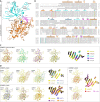Structure of human aspartyl aminopeptidase complexed with substrate analogue: insight into catalytic mechanism, substrate specificity and M18 peptidase family
- PMID: 22720794
- PMCID: PMC3472314
- DOI: 10.1186/1472-6807-12-14
Structure of human aspartyl aminopeptidase complexed with substrate analogue: insight into catalytic mechanism, substrate specificity and M18 peptidase family
Abstract
Background: Aspartyl aminopeptidase (DNPEP), with specificity towards an acidic amino acid at the N-terminus, is the only mammalian member among the poorly understood M18 peptidases. DNPEP has implicated roles in protein and peptide metabolism, as well as the renin-angiotensin system in blood pressure regulation. Despite previous enzyme and substrate characterization, structural details of DNPEP regarding ligand recognition and catalytic mechanism remain to be delineated.
Results: The crystal structure of human DNPEP complexed with zinc and a substrate analogue aspartate-β-hydroxamate reveals a dodecameric machinery built by domain-swapped dimers, in agreement with electron microscopy data. A structural comparison with bacterial homologues identifies unifying catalytic features among the poorly understood M18 enzymes. The bound ligands in the active site also reveal the coordination mode of the binuclear zinc centre and a substrate specificity pocket for acidic amino acids.
Conclusions: The DNPEP structure provides a molecular framework to understand its catalysis that is mediated by active site loop swapping, a mechanism likely adopted in other M18 and M42 metallopeptidases that form dodecameric complexes as a self-compartmentalization strategy. Small differences in the substrate binding pocket such as shape and positive charges, the latter conferred by a basic lysine residue, further provide the key to distinguishing substrate preference. Together, the structural knowledge will aid in the development of enzyme-/family-specific aminopeptidase inhibitors.
Figures





Similar articles
-
Insights into substrate specificity and metal activation of mammalian tetrahedral aspartyl aminopeptidase.J Biol Chem. 2012 Apr 13;287(16):13356-70. doi: 10.1074/jbc.M112.347518. Epub 2012 Feb 22. J Biol Chem. 2012. PMID: 22356908 Free PMC article.
-
Structural basis for the substrate specificity of PepA from Streptococcus pneumoniae, a dodecameric tetrahedral protease.Biochem Biophys Res Commun. 2010 Jan 1;391(1):431-6. doi: 10.1016/j.bbrc.2009.11.075. Epub 2009 Nov 13. Biochem Biophys Res Commun. 2010. PMID: 19914209
-
Structural and kinetic bases for the metal preference of the M18 aminopeptidase from Pseudomonas aeruginosa.Biochem Biophys Res Commun. 2014 Apr 25;447(1):101-7. doi: 10.1016/j.bbrc.2014.03.109. Epub 2014 Apr 1. Biochem Biophys Res Commun. 2014. PMID: 24704201
-
TET peptidases: A family of tetrahedral complexes conserved in prokaryotes.Biochimie. 2016 Mar;122:188-96. doi: 10.1016/j.biochi.2015.11.001. Epub 2015 Nov 4. Biochimie. 2016. PMID: 26546839 Review.
-
Structural features of angiotensin-I converting enzyme catalytic sites: conformational studies in solution, homology models and comparison with other zinc metallopeptidases.Curr Top Med Chem. 2004;4(4):403-29. doi: 10.2174/1568026043451294. Curr Top Med Chem. 2004. PMID: 14965309 Review.
Cited by
-
Molecular characterization of a novel aspartyl aminopeptidase that contributes to the increase in glutamic acid content in chicken meat during cooking.Food Chem (Oxf). 2021 Feb 17;2:100015. doi: 10.1016/j.fochms.2021.100015. eCollection 2021 Jul 30. Food Chem (Oxf). 2021. PMID: 35415631 Free PMC article.
-
Structure of yeast Ape1 and its role in autophagic vesicle formation.Autophagy. 2015;11(9):1580-93. doi: 10.1080/15548627.2015.1067363. Autophagy. 2015. PMID: 26208681 Free PMC article.
-
Small-angle neutron scattering reveals the assembly mode and oligomeric architecture of TET, a large, dodecameric aminopeptidase.Acta Crystallogr D Biol Crystallogr. 2014 Nov;70(Pt 11):2983-93. doi: 10.1107/S1399004714018446. Epub 2014 Oct 23. Acta Crystallogr D Biol Crystallogr. 2014. PMID: 25372688 Free PMC article.
-
Drug targeting of aminopeptidases: importance of deploying a right metal cofactor.Biophys Rev. 2024 Apr 24;16(2):249-256. doi: 10.1007/s12551-024-01192-8. eCollection 2024 Apr. Biophys Rev. 2024. PMID: 38737204 Free PMC article. Review.
-
Molecular and structural mechanisms of ZZ domain-mediated cargo selection by Nbr1.EMBO J. 2021 Aug 2;40(15):e107497. doi: 10.15252/embj.2020107497. Epub 2021 Jun 25. EMBO J. 2021. PMID: 34169534 Free PMC article.
References
-
- Taylor A. Aminopeptidases: structure and function. FASEB J. 1993;7(2):290–298. - PubMed
Publication types
MeSH terms
Substances
Associated data
- Actions
Grants and funding
LinkOut - more resources
Full Text Sources
Other Literature Sources
Molecular Biology Databases

